Efficient thin film CdS/CdTe solar cell performance requires optimum parameters of each layer of this cell and of the barrier structure.Moreover, the effect of optical losses, recombination losses at front and back surface of CdTe and recombination losses in the space-charge region (SCR) must be considered in order to really analyze the role of these parameters on the performance of these cells. This work is focused on studying theoretically the effect of the thickness of the front contact (ITO), thickness of the window layer (CdS), thickness of the absorber layer (CdTe), width of the space-charge region and electron lifetime on the efficiency of CdS/CdTe solar cells. The reflection losses frominterfaces and absorption losses in ITO and CdS, front and rear surface recombination losses of CdTe as well as recombination losses in SCR have been studied. It has been observed that the short-circuit current strongly depends on the thickness of ITO, thickness of CdS, thickness CdTe and electron lifetime. The concentration of uncompensated impurities (Na−Nd) in CdTe, which determines the width of SCR, plays a key role in the generation of photocurrent. The recombination losses in the SCR decrease rapidly with increasing the carrier lifetime in this region and can be ignored at lifetime of 10−7 s. The reflectivity from the back contact introduces a small influence in increasing the short-current density particularly at thick absorber layer (5–8 μm). Under the conditions of Na − Nd ~ 1016 cm−3, τn = 10−6 s, dCdTe = 8μm, dITO = 100 nm, and dCdS = 100 nm, the recombination and optical losses record their minimum ratio of 27%. Most of these losses (24%) are due to the optical losses. The efficiency of CdS/CdTe under these parameters is about 18.2% which is exactly matching with the recent experimental studies. Moreover, an ultrathin CdTe (=1 μm) is sufficient to introduce high efficiency of 16.4%.

